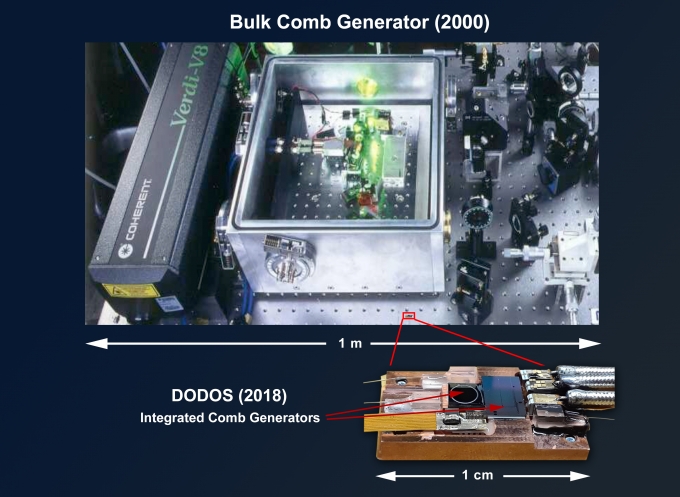Only a few decades ago, finding a particular channel on the radio or television meant dialing a knob by hand and then making small adjustments to home in on the right signal. That’s no longer the case, thanks to something called a radio-frequency synthesizer, which generates accurate signal frequencies. The need for better radar in World War II drove the development of radio-frequency control, and the technology was miniaturized over subsequent decades, revolutionizing a host of military and consumer applications. Today, precise, stable frequency synthesizers are found everywhere, from GPS systems to smartphones.
While radio-frequency control has long since been mastered, optical-frequency control, on the other hand, still exists in the bygone “tuner knob” era. This is because optical frequencies are so much higher, 200 million MHz, whereas RF frequencies are around 100 MHz. It is difficult to set the absolute frequency, or color, of light emitted from a laser with precision, and laser frequencies tend to drift, as radio stations once did. A 2005 Nobel Prize was awarded to developers of the first “optical-frequency comb,” which enabled the first optical-frequency synthesizer. Those systems, analogous to their radio-frequency counterparts, allow light to be generated on demand at exact wavelengths, with errors of less than 10-15, or one part per quadrillion. Optical-frequency synthesizers have proven extremely valuable in a variety of scientific endeavors, including searching the skies for far-off planets, detecting chemicals through sensitive laser spectroscopy, and enabling high-precision light detection and ranging (LIDAR) by using light as a ruler to measure distance.
While optical-frequency synthesizers provide unprecedented performance, until now, they have been large, expensive, and power hungry. To address those limitations, in 2014 the Defense Advanced Research Projects Agency (DARPA) launched the Direct On-Chip Digital Optical Synthesizer (DODOS) program. Now, in a paper published April 26 in Nature, researchers from UCSB, NIST, Caltech, Juniper, Ligentec, UVa and EPFL, including UCSB professor and principal investigator John Bowers and fellow electrical and computer engineering professor Luke Theogarajan, plus four UCSB graduate-student researchers, describe significant advances in chip-based integrated photonics and nonlinear optics, resulting in miniature, energy-efficient components for an optical synthesizer.
“The development of optical-frequency synthesis has significantly enhanced our ability to accurately and precisely measure time and space,” said Gordon Keeler, the DARPA program manager leading DODOS. “However, our ability to leverage the technology has been limited. Through DODOS, we’re creating technologies that will enable broader deployment and unlock numerous applications. The goal is to shrink laboratory-grade capabilities down to the size of a sugar cube for use in applications like LIDAR, coherent communications, chemical sensing, and precision metrology [measurement].”
Combining a pair of frequency combs, several miniature lasers, and other compact optoelectronic components, the researchers were able to replicate the capabilities of a tabletop-sized optical-frequency synthesizer on three microchips, each less than 5 mm x 10 mm in size.
“We took something that occupied a whole optical bench, weighed fifty pounds, and used a kilowatt of power and made it orders of magnitude more efficient by integrating the key elements onto silicon photonic integrated circuits,” Bowers said.
Theogaragan and his students designed and developed electrical integrated circuits to control the synthesizer, which can tune over 50 nanometers and deliver a frequency stability of 7 x 10-13 after one second of averaging, matching that of the input reference clock.
A stable clock is important, because, Bowers explains, “The more accurate the clock is, the better you can resolve distance or velocity or do navigation. GPS has a certain resolution. Your phone will locate you to within a few meters. But if you had a better, more stable clock, you could triangulate more precisely and get better resolution. It’s called PNT, for “precision navigation and timing.” The optical synthesizer output is the programmable laser, and its light-wave oscillations serve as an optical clock traceable to the SI second, the international standard of time based on the microwave vibrations of the cesium atom. The output laser is guided by the two frequency combs, which provide synchronized links between microwave and optical frequencies.
Researchers created the two miniaturized frequency combs by circulating laser light generated with single-color “pump” lasers around optical racetracks fabricated on silicon chips. Doing so correctly can produce many additional colors, yielding a spectrum that looks like a hair comb where each “tooth” is an individual color, or frequency. This is a significant departure from the tabletop version of an optical-frequency synthesizer, which uses fiber optics, specialized mirrors, and large mechanical components built by hand to achieve a similar effect.
The two frequency combs guide a programmable laser, which is an output of the synthesizer. One comb, created by NIST, Ligentec and EPFL, has wider teeth and can calibrate itself by spanning an octave – which represents a doubling of frequency, as in musical octaves. The team from Caltech created a second comb that has much finer teeth and spans a narrower range. When lined up to the NIST comb, the Caltech comb creates a grid of known optical frequencies for the output laser to reference – or measure itself against. In combination, the frequency combs create a synchronized link between a microwave clock and the laser frequency.
The DODOS program is entering its final phase, during which researchers will work to integrate the individual components together with electronics and fabricate a compact packaged device suitable for use in future military and commercial optical systems.
The synthesizer could have applications in navigation, spectroscopy, and astronomy. The goal, Bowers said, is “to make this very precise miniature laser cost almost nothing.”

The original meter-wide bench-top optical frequency synthesizer (top) shown with the new 1-centimeter-wide DODOS version on it, approximately to scale, and in expanded view (bottom)
